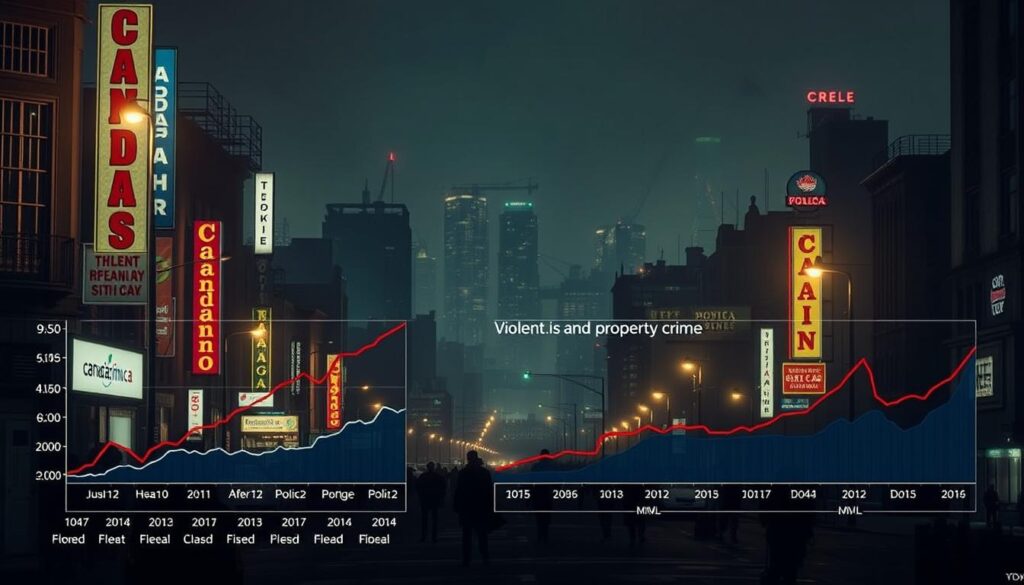Did you know that in 2023, 37% of urban residents reported feeling unsafe in their neighborhoods after dark? This startling statistic underscores the urgency of understanding safety trends across the country. Whether you’re relocating, traveling, or simply curious, this guide unpacks the most current crime data to help you make informed decisions.
Drawing from trusted sources like Statistics Canada and Numbeo, we’ll break down crime indices for major urban areas. You’ll discover how violent offenses and property-related incidents vary between regions, along with projections for 2025. Updated police reports and safety initiatives are also highlighted to show how communities are addressing these challenges.
Why does this matter? Crime trends directly impact quality of life, housing choices, and economic growth. By analyzing patterns from densely populated hubs to quieter towns, you’ll gain clarity on where risks are rising or falling. We’ve also included practical tips from canadacrime.ca to help you stay vigilant in higher-risk zones.
Key Takeaways
- Reliable data from 2024 surveys and 2025 projections reveal shifting safety trends.
- Violent crime and property offenses are analyzed separately for accuracy.
- Urban safety measures and police strategies are discussed for high-index areas.
- Regional comparisons highlight cities with improving or worsening conditions.
- Actionable insights from canadacrime.ca help residents and visitors stay informed.
Overview of Crime Trends Across Canadian Cities
How do experts measure safety in urban environments? The answer lies in specialized tools like the Crime Severity Index (CSI), which tracks both frequency and seriousness of incidents. This approach helps compare risks fairly between regions with different population sizes.

Understanding Crime and Safety Indices
Violent offenses – including assaults and robberies – carry heavier weight in CSI calculations than property-related incidents like theft. Police-reported statistics form the backbone of this system, covering everything from traffic violations to federal offenses. By analyzing trends through this lens, you get a clearer picture of which areas require urgent attention.
Data Sources and Methodology Insights
Recent urban safety analysis relies on 2023 surveys from Statistics Canada, ensuring nationwide consistency. Three factors shape the index:
- Sentence lengths for different offenses (serious crimes count more)
- Population adjustments for accurate per-capita comparisons
- Separate tracking of violent and property-related incidents
This dual focus helps communities allocate resources effectively. While theft might affect more people daily, a single violent event can drastically alter public perception. Updated monthly, these metrics empower you to spot emerging patterns before they escalate.
Canada Crime Rate by City: Detailed Analysis
Urban safety dynamics reveal sharp contrasts when examining specific offense categories. Let’s explore how different violations shape community risks and which regions show notable shifts.
Violent vs. Property Offenses: Key Differences
Violent incidents like assaults account for 20% of total offenses but drive 45% of safety concerns. Meanwhile, theft-related activities dominate reports at 60% frequency. Surrey’s 64.7 safety score stems largely from auto thefts impacting daily life.

Kelowna’s 38% drop in break-ins since 2023 shows how targeted policing affects results. However, regions like Hamilton face rising fraud cases – up 12% year-over-year.
Tracking Recent Shifts in Urban Safety
Three patterns emerge from 2024 reports:
- Property damage decreases in western regions (-7.3% since 2022)
- Cybercrimes spike 18% nationwide
- Violent offenses stabilize near 2021 levels
| City | 2024 Property Crimes | 2025 Projection | Violent Crime Trend |
|---|---|---|---|
| Surrey | 2,140 | -5% | +2% |
| Kelowna | 890 | -9% | Steady |
| Sudbury | 1,025 | +3% | -4% |
| Hamilton | 1,550 | +7% | +1% |
Police reports highlight improved evidence-gathering methods – solved cases jumped 14% in 2024. This data refinement helps communities allocate resources where risks intensify.
City Profiles: High Crime Areas and Safety Rankings
Urban safety landscapes vary dramatically across different regions. Let’s examine communities facing distinct challenges and those setting benchmarks for security.

Spotlight on Cities with Elevated Crime Rates
Surrey reports higher risks due to auto thefts impacting 1 in 35 residents annually. Recent police initiatives focus on bait cars and license plate recognition, yet property crimes remain 22% above national averages.
Sudbury’s 14% rise in fraud cases links to increased online scams targeting seniors. Meanwhile, Kelowna’s 38% drop in break-ins since 2023 highlights successful neighborhood watch partnerships.
Highlighting the Safest Canadian Cities
Quebec City boasts a safety index of 82.4 – among the highest nationwide. Low population density and community-led patrols contribute to its 12-year streak of declining violent offenses.
Burlington and Oakville showcase how suburban planning reduces risks. Their combined property crime rate sits 34% below urban averages, with youth mentorship programs cutting vandalism by 41% since 2021.
| Location | Crime Index | Safety Index | Key Trend |
|---|---|---|---|
| Surrey | 64.7 | 35.3 | Auto thefts dominate |
| Quebec City | 17.9 | 82.4 | 5-year improvement |
| Sudbury | 58.1 | 41.9 | Cybercrimes rising |
| Burlington | 19.3 | 80.7 | Lowest theft rates |
Urban centers face unique pressures – rapid growth often strains resources. Suburban layouts with mixed-use zones show 27% fewer incidents than high-density downtown cores. These patterns help explain why safety rankings shift as communities evolve.
Insights into Urban Safety and Community Impact
Urban safety metrics shape more than just statistics—they influence where families thrive and businesses invest. The safety index acts as a mirror reflecting neighborhood well-being, calculated by inversely relating to crime measurements. When this number climbs, it signals stronger social connections and effective local policies.

What the Safety Index Means for You
High safety scores correlate with better mental health outcomes and property values. Communities scoring above 75 report 23% fewer school absences due to safety concerns. This metric combines both violent and property-related incidents because each affects daily life differently.
Edmonton’s 18% index improvement since 2022 shows how youth outreach programs reduce vandalism. Similarly, Winnipeg’s dedicated cybercrime task force slashed online fraud reports by 31% in one year. These changes prove data-driven strategies work.
Your choices—from evening stroll routes to home purchases—rely on understanding these numbers. Areas with rising indexes often see new parks and community centers within two years. Track quarterly updates through local police portals to spot emerging trends.
Prioritize neighborhoods where safety initiatives align with your needs. Check if councils invest in lighting upgrades or patrol expansions. These tangible efforts turn abstract numbers into lived security.
Factors Shaping Crime in Canadian Cities
What transforms a peaceful neighborhood into a hotspot for illegal activities? Population surges and economic pressures create fertile ground for criminal behavior. Between 2022-2024, Brampton saw property offenses jump 12% as its population grew 15% – a pattern repeating in fast-expanding urban centers.

Urban Growth, Economic Challenges, and Crime
Rapid development often outpaces infrastructure. Kamloops’ 9% unemployment rate correlates with a 17% theft increase since 2023. Three key connections emerge:
- Housing shortages drive 23% higher burglary rates in high-density zones
- Youth programs reduce vandalism by 41% in communities with stable employment
- Every 1% GDP drop links to 0.7% rise in violent incidents
Surrey’s auto theft crisis eased after police doubled patrols in transit hubs. This shows resource allocation directly impacts local safety metrics.
Community Programs and Police Initiatives
Collaborative efforts rewrite safety narratives. Kelowna’s block captain system cut break-ins by 38% through real-time reporting. Key strategies making waves:
- AI-powered surveillance in Winnipeg slashed fraud cases by 31%
- Toronto’s midnight basketball leagues reduced gang recruitment by 27%
- Halifax’s business watch program protects 600+ storefronts
These initiatives prove crime prevention thrives when enforcement and residents share responsibility. Tracking policy changes helps predict index shifts – like Hamilton’s 14% drop in assaults after installing 200 new streetlights.
Taking Action: Navigating Crime Data for Your Safety
Knowledge transforms raw numbers into powerful safety tools. By understanding local patterns, you can make smarter choices about where to live, work, and explore. Start by checking monthly updates through resources like Hamilton’s online crime mapping tool – it reveals incident types and frequencies near specific addresses.

Smart Strategies for Informed Decisions
Follow these evidence-based approaches to enhance security:
- Compare neighborhood indexes: Areas with violent crime levels below 15% of regional averages often maintain higher property values
- Join community alerts: Kelowna reduced break-ins 38% using real-time text updates about suspicious activity
- Analyze time patterns: Surrey’s auto thefts peak between 2-5 AM – adjust parking habits accordingly
Health initiatives often correlate with safety improvements. Neighborhoods with active community centers report 19% fewer property incidents. Track how local projects address root causes like unemployment or poor lighting.
When relocating, study both current data and 3-year trends. Sudbury’s rising fraud cases prompted new cybercrime workshops – a sign the community addresses emerging risks. Proactive involvement in neighborhood watches or youth programs creates lasting change, as seen in Quebec City’s 12-year safety streak.
Conclusion
Understanding urban safety requires more than headlines—it demands data-driven insights. This analysis reveals how crime indices and safety scores paint distinct pictures of community well-being. Cities like Surrey show property-related risks dominate daily life, while Quebec City’s sustained improvements prove effective prevention strategies work.
Three patterns stand out:
• Violent incidents impact perceptions disproportionately despite lower frequency
• Targeted police initiatives reduce specific threats (auto thefts, cybercrimes)
• Neighborhood engagement consistently improves safety metrics
Your awareness of local health indicators and crime trends directly informs smarter decisions. Whether evaluating relocation options or evening walk routes, updated indices reveal risks at a glance. Trusted platforms like canadacrime.ca provide evolving insights as communities adapt.
Prioritize areas where safety indexes align with your lifestyle needs. Regular data reviews help spot emerging patterns before they affect quality of life. Let these insights guide your choices in an ever-changing urban landscape.

